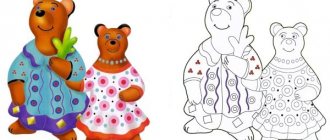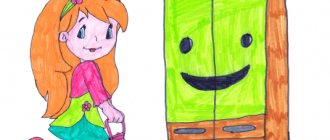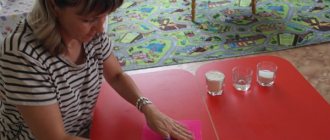Drawing lesson in the senior group “Decorative drawing based on Dymkovo painting”
Drawing lesson in the senior group “Decorative drawing based on Dymkovo painting”
Software tasks:
Consolidate knowledge about Dymkovo toys; Strengthen the skills of drawing elements of Dymkovo painting (circles, dots, stripes, grid, ring, wavy arcs); Strengthen children’s ability to create a decorative composition in the Dymkovo painting genre; Learn on your own, create a pattern on a product of a new shape from familiar elements, place it near the frill in accordance with the shape of the skirt or dress; Strengthen the techniques of drawing smooth lines when working with a brush and the ability to draw with the tip of a brush. To cultivate respect for the work of folk craftsmen and admiration for their creativity.
Equipment:
Several drawings of Dymkovo toys, pictures with elements of the Dymkovo pattern; watercolor paints, brushes, water, napkins, ready-made template drawings of the Dymkovo young lady.
Preliminary work:
The teacher's story, looking at albums and paintings about Dymkovo toys; conversations, conversations about the Dymkovo toy.
Progress of the lesson:
Educator:
Today, children, I invite you to the gallery of drawings of the Dymkovo toy. Look how beautiful it is here! And how many different young ladies! Let's look at them. (Children independently examine toys painted in the style of Mist.) They are all so bright, beautiful and very different. But they also have something in common! Guys, think and tell me what are the names of all these toys? (Dymkovskys).
- Why are they called that?
“Far, far away, behind dense forests, behind green fields, on the banks of a blue river there stood a large village. Every morning people got up, lit the stoves, and blue smoke curled out of the chimneys of their houses. There were many houses in the village. So they called that village Dymkovo. Cheerful and mischievous people lived in that village. They loved to sculpt funny, bright, colorful toys and whistles. They will make a lot of them over the long winter. And when the golden spring sun rises in the sky, the snow runs away from the fields, cheerful people bring out their cheerful toys and, well, whistle - drive away winter, glorify spring. Funny toys were sold in different cities and villages. And after this name, the village and toys began to be called Dymkovo.
— What color are Dymkovo toys? (Always white only)
— What are the patterns on Dymkovo toys? (Straight line, wavy line, dot, circle, ring, cage, grid)
- Which color is more? What colors are used?
— What techniques are used to make the patterns? (By dipping, the end of the brush, brush flat on the pile)
- Look at these young ladies: how are they similar to each other? (Everyone has wide dresses, skirts, aprons, beautifully decorated)
- Right! But these dresses remained white! They are offended and stand on the side. Let's help the young ladies and paint their dresses. Let them also stand proudly at this exhibition, and be glad that they, too, were decorated with beautiful colors. Try to make it bright and elegant. Don’t forget: we draw the lines with the tip of the brush, and apply patterns on the circles only after the circles have dried.
- Sit down comfortably, let's get started.
During independent work, the teacher keeps all the children in sight, helps those who have difficulty creating a composition, monitors the landing, and the technique of performing the work.
After 10 minutes of independent work, there is a physical education break.
We tried to draw (arms to the sides) It was difficult not to get tired (torso tilted to the sides) We will rest a little (sit down, arms forward) Let’s start drawing again (stand up, lower your arms)
- Now finish your work, finish drawing the patterns, and then look at the drawings.
To summarize, the teacher hangs up all the drawings, offers to choose the most elegant young ladies and answer the questions:
1. What job did you like best? Why? 2. What did you like most here? 3. What's special about this job? 4. How is this job different from others?
Well done, everyone tried to create new beautiful Dymkovo patterns. The lesson is over.
Summary of an art lesson in the senior group on the topic “Dymkovo settlement (village)”
Summary of a lesson in visual arts for children of senior preschool age on the topic: “Dymkovo settlement (village)”
Purpose: To create conditions for the development of artistic creativity in children of senior preschool age. Objectives: Educational:
To consolidate children’s knowledge about Dymkovo toys and Dymkovo painting.
To consolidate an emotionally positive attitude towards folk decorative art. Developmental:
Develop aesthetic perception, figurative ideas, sense of color and composition.
Develop a sense of beauty and creative abilities. Continue to develop teamwork skills. Educational:
To cultivate respect and interest in folk crafts.
Integration of educational areas: artistic and aesthetic development, cognitive development, physical development, speech development, social and communicative development. Glossary: folk crafts, Dymkovo toy, Dymkovo settlement, elements of painting, village, master. Preliminary work: teacher's story about folk crafts, the history of the emergence of Dymkovo toys, looking at Dymkovo toys, reading fiction, memorizing poems about folk crafts, getting acquainted with the elements of Dymkovo painting, drawing Dymkovo patterns, sculpting folk toys, watching a multimedia presentation about folk crafts "Dymkovo Sloboda", cutting out silhouettes of Dymkovo toys from white paper. Methods and techniques: • Visual (examination of the painting “Dymkovskaya Sloboda”, illustrations of young ladies, samples of painting elements)” • Verbal (search and problem questions, explanation, encouragement, teacher’s story, finger gymnastics) • Game (finger gymnastics) • Practical (painting silhouettes of various Dymkovo toys) • Problematic (problem situation) Materials and equipment: Dymkovo toy (lady), silhouettes of Dymkovo toys cut out of white paper in advance, samples of Dymkovo painting elements, projector, gouache paints, brushes, jar of water, napkin (on each child), a large sheet of whatman paper decorated to resemble the painting “Dymkovskaya Sloboda”.
Progress of the lesson
The teacher draws the children's attention to a picture with a view of the Dymkovo settlement and continues to introduce the children to the history of the Dymkovo toy.
Educator: Look at the picture. What kind of village is it in the haze?
Right. Far, far away, behind dense forests, behind green fields, on the banks of a blue river there stood a large village. Every morning people got up, lit the stoves, and blue smoke curled out of the chimneys of their houses. There were many houses in the village. So they called that village Dymkovo. Cheerful and mischievous people lived in that village. They loved to sculpt funny, bright, colorful toys and whistles. They will make a lot of them over the long winter. And when the golden spring sun rises in the sky, the snow runs away from the fields, cheerful people bring out their cheerful toys and, well, whistle - drive away winter, glorify spring. Funny toys were sold in different cities and villages. And after this name, the village and toys began to be called Dymkovo. Educator : Guys, look who is sad here on the side? (The teacher pays attention to the lady on the side) Educator: She was long ago taken away from her native village, from Dymkovskaya Sloboda, and she really misses her friends. How do you think we can help the Dymkovo toy? Educator: I propose that we all create Dymkovo Sloboda , how can we do this? Educator: look, we have a large sheet of paper on which there are houses - this is a village in which there is no one yet, let's settle cheerful residents here and invite our guest.
and on the table there are many silhouettes of various Dymkovo toys. Choose any toy
think about which pattern suits her best and start painting, I think you will make very beautiful friends for our guest. Let's remember what colors and elements the haze masters use. Educator: Guys, before we start drawing, let’s stretch our fingers. Finger gymnastics: Our fingers will tell They can do everything, they will show everyone Five of them on my hand They can do everything They can always help They can draw Sticks, circles Multi-colored ovals Rings or dots We will get down to business Eh, the work is in full swing! Educator: Don’t forget about correct posture when working at the table. The teacher helps and praises the children.
As the products are ready, the children, together with the teacher, lay out the figures on a large sheet of paper, creating the picture “Dymkovskaya Sloboda”. Educator: Look how cheerful our guest is, she thanks you for your friendly work, for the joy that you brought her. Tell her which toys you liked best and why. What do you think is the brightest and most elegant toy? What elements of Dymkovo painting did you use in your work? Educator: Guys, today you worked like real Russian masters, I’m proud of you. You tried and worked very hard and what a beautiful teamwork we did! Dymkovskaya Sloboda!
We recommend watching:
Summary of an art lesson for preschoolers aged 5-7 years. New Year's tree Educational situation in fine arts in the senior group using non-traditional drawing techniques Abstract of GCD in the senior group experimentation in art activities: Drawing on water Synopsis of fine arts in the senior group in non-traditional techniques. Autumn
Similar articles:
Cognitive lesson in the senior group






